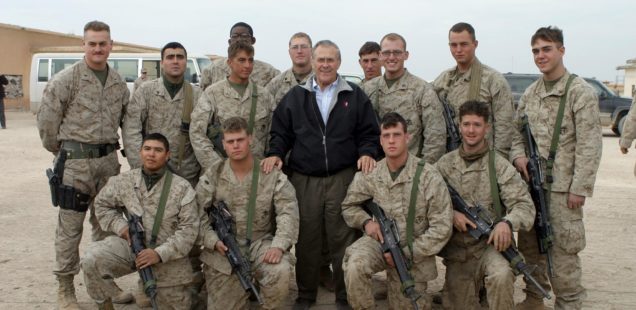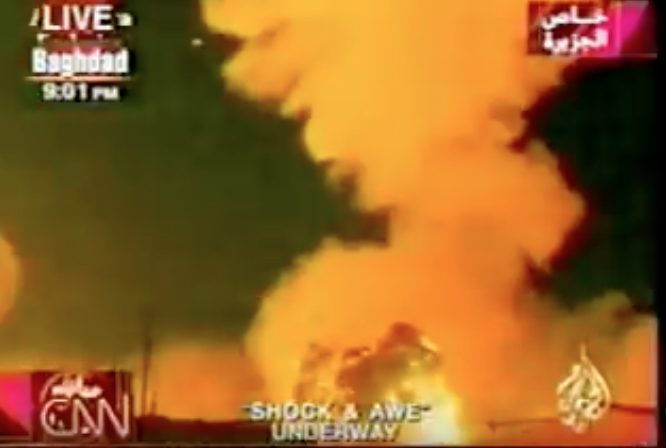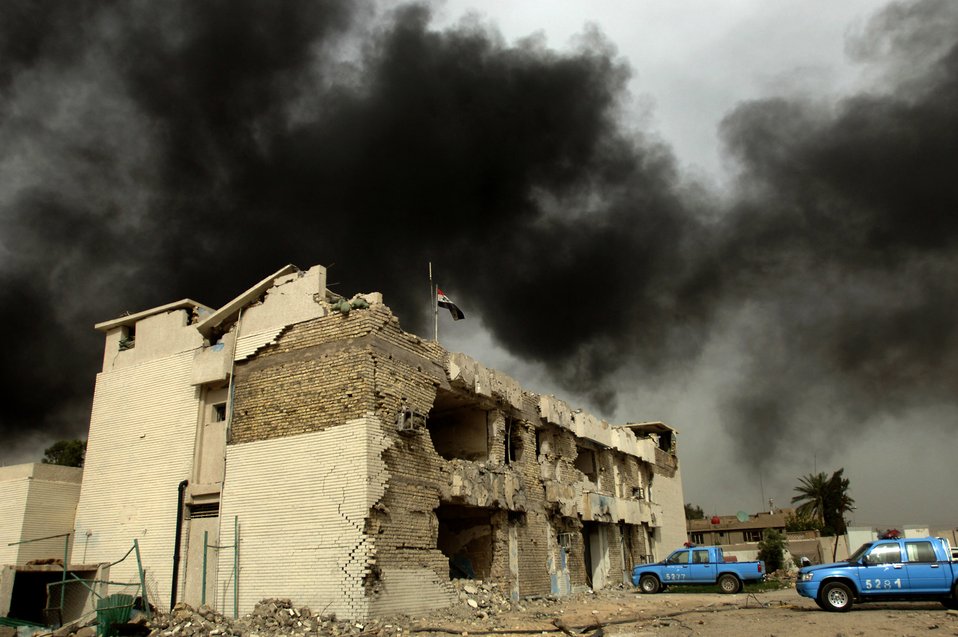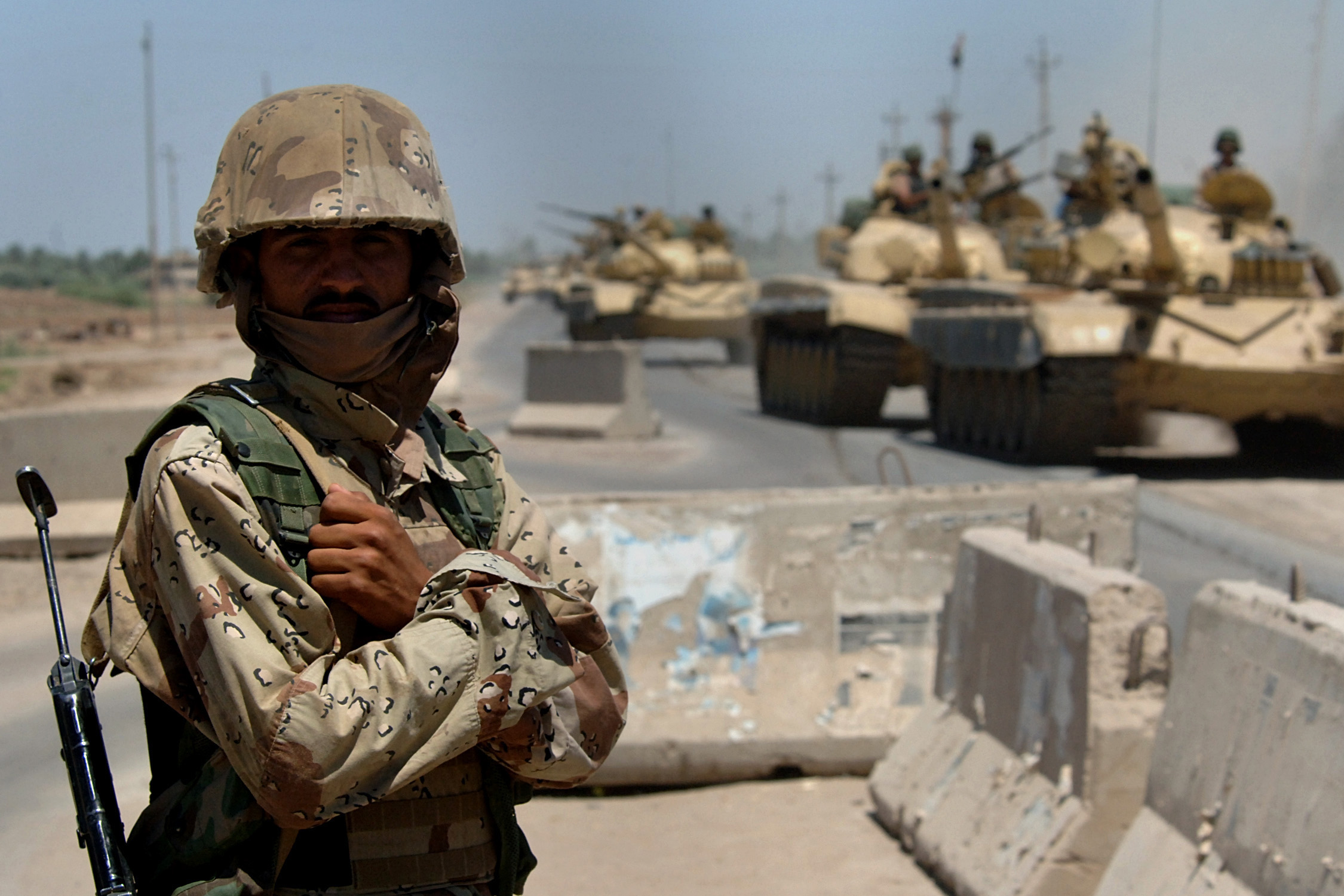
The Revelations of WikiLeaks: No. 3—The Most Extensive Classified Leak in History
The “Iraq War Logs” disgorged an unprecedented profusion of documents, military reports and videos, reports Patrick Lawrence.
For WikiLeaks, 2010 was an exceptionally eventful year. In April the transparency organization released “Collateral Murder,” the video of U.S. Army helicopters as they shot more than a dozen Iraqis in Baghdad. That proved a worldwide shock and put the 4-year-old publisher on the global media map.
“Afghan War Diaries,” a cache of 75,000 documents, followed in July.
Three months later, on Oct. 22, 2010, WikiLeaks released an even more explosive trove: 391,831 documents and videos it named “Iraq War Logs.” This superseded “Afghan War Diaries” as by far the most extensive leak of classified material in U.S. history. It shone a stark light on the U.S.–led coalition’s conduct in Iraq after its 2003 invasion, when the nation had erupted into a violent sectarian war. Julian Assange, WikiLeaks founder, said the Logs “constituted the most comprehensive and detailed account of any war ever to have entered the public record.”

The source for the “Iraq War Logs” was once again Chelsea Manning, who by then was in a military prison awaiting trial on charges connected to “Collateral Murder” that wound up including 22 counts of theft, assisting the publication of classified intelligence and aiding the enemy.
The Documents
With the publication of the “Iraq War Logs,” WikiLeaks disgorged an unprecedented profusion of documents, military reports and videos.
The Logs cover the six-year period from Jan. 1, 2004, (a matter of months after the 2003 invasion) to Dec. 31, 2009. WikiLeaks partnered with The New York Times, The Guardian, Der Spiegel, Al Jazeera and Le Monde to disseminate the Iraq Logs.
Taken together, the Logs portray Iraq under allied occupation as the scene of lawless mayhem and violence. Codes of conduct were routinely ignored, shootings were often indiscriminate and torture of detainees was regularly treated as acceptable practice. Innocent civilians were under constant threat of U.S.-led coalition gunfire and arrest, interrogation, and mistreatment by allied military units and the Iraqi army and police.
Among the Logs’ most significant revelations:
Torture of Detainees
The Iraqi military and police systematically tortured prisoners — including women, children and other civilians — with the tacit approval (and at times the complicity) of U.S. forces. On numerous occasions U.S. troops were directly responsible for the torture of detainees. Here is a typical report of prisoner abuse by a Special Operations unit. The incident occurred on Feb. 2, 2006; the report conveys the routine fashion in which the coalition treated such events. The detainees name, the Special Operations unit’s name, and the location of the incident are deleted:
ALLEGED DETAINEE ABUSE BY TF ___ IN ___ 2006-02-02 17:50:00
AT 2350C, IN ___, WHILE CONDUCTING OUT-PROCESSING, DETAINEE # ___ REPORTED THAT HE WAS ABUSED DURING HIS CAPTURE. DETAINEE IS MISSING HIS RIGHT EYE, AND HAS SCAR___ ON HIS RIGHT FOREARM. DETAINEE STATES THAT HIS INJURIES ARE A RESULT OF THE ABUSE THAT HE RECEIVED UPON CAPTURE. DIMS INDICATE THAT THE DETAINEE WAS CAPTURED ON ___ IN ___, AND THE CAPTURING UNIT WAS TASK FORCE ___. THE DETAINEES CAPTURE TAG NUMBER IS ___. IN PROCESSING PERSONNEL STATE THAT THE DETAINEE___ CAPTURE PHOTO DEPICTS A BANDAGE OVER HIS RIGHT EYE, AND INJURY TO HIS RIGHT FOREARM. THE DETAINEE HAS COMPLETED THE DETAINEE ABUSE COMPLAINT FORM, AND WE ARE SEEKING A SWORN STATEMENT FROM THE DETAINEE. PER ORDER OF Task force ___, THE DETAINEE ___ TRANSFERRED AS SCHEDULED, AND CONTINUE CID INVESTIGATION UPON ARRIVAL AT ___ GHRAIB.
There are many thousands of similar reports detailing the violent misconduct of coalition and Iraqi forces.
Among WikiLeak’s key revelations, scarcely mentioned in U.S. media reports, were the American army’s secret orders effectively requiring U.S. military units to ignore thousands of cases of “green-green” torture, violence and murder — incidents involving Iraqi detainees held at Iraqi army bases, police stations and prisons. The list of common green-green practices makes repellent reading. Accounts of such incidents, sometimes accompanied by video shot as they occurred, detail beatings of blindfolded prisoners; stabbings; electrocutions; whippings with wires; and sodomy with hoses, water bottles and other objects.

The first U.S. orders covering these incidents were issued in June 2004, two months after the torture practices of U.S. troops at Abu Ghraib broke into the news. The orders were called Frago 242, meaning “fragmentary orders.” Providing there was no U.S. involvement in an incident, American forces were told not to investigate it “unless directed by higher headquarters,” or HHQ. Frago 039, a subsequent order issued in April 2005, required U.S. troops to report green-green incidents; U.S. troops would report more than 1,300 cases of green-green torture to their commanding officers. But, once again, they were ordered to take no further action. Frago 242 and 039 were clear breaches of U.S. responsibility in Iraq.
Here is an example of the reports U.S. forces routinely filed after Frago 242 and Frago 039 were issued. It recounts the apparent murder of a detainee while in Iraqi custody. The incident occurred on Aug. 9, 2009, in Ramadi. Iraqi officials termed the detainee’s death a suicide, while the U.S. report found the detainee’s injuries “consistent with abuse.” The U.S. military closed the case the following October; there is no indication any action was taken:
Date: 2009-08-27 09:00:00
Type: Suspicious Incident
Category: Other
Tracking no.: 20090827090038SLB413998
Title: (SUSPICIOUS INCIDENT) OTHER RPT RAMADI IRAQI CTU : 1 UE KIA
Summary: WHO: RAMADI PGC TT
WHAT: Reports possible detainee abuse
WHEN: 270900C AUG 09
WHERE: Iraqi CTU in Ramadi IVO (38S LB 413 998)
HOW: At 270900C AUG 09, the PGC TT reports possible detainee abuse IVO (38S LB 413 998). On 26 Aug 09, a PGC TT (which included a USN Corpsman) conducted a post mortem visual examination of JASIM MOHAMMED AHMED AL-SHIHAWI, an individual arrested in conjunction with a VBIED interdicted NE of Camp Taqaddum (SIGACT Entry DTG: 241130CAug09). The detainee was transferred from the IHP in Saqlawiah to the Iraqi CTU in Ramadi for questioning and while in custody, reportedly committed suicide. The PGC TT personnel conducting the post mortem examination found bruises and burns on the detainee`s body as well as visible injuries to the head, arm, torso, legs, and neck. The PGC TT report the injuries are consistent with abuse. The CTU/IP have reportedly begun an investigation into the detainees death. An update will be posted when more information becomes available. The SIR is attached.
CLOSED 20091019
On Oct. 24, 2010, two days after WikiLeaks published the “Iraq War Logs,” Al Jazeera released “U.S. Turns a Blind Eye to Torture.” The video details the Frago 242 and 039 stipulations as revealed in the Logs. While some incidents were eventually investigated — apparently including the one in Ramadi — there is no record of Iraqi personnel receiving a sentence for misconduct. The Al Jazeera report traces knowledge of the orders to “the highest levels of the U.S. government” — including, the video makes plain, Donald Rumsfeld, then defense secretary.
Civilian Deaths
For the first two years following the 2003 invasion, U.S. military authorities denied keeping records of civilian deaths in Iraq. Only in 2005, when the Defense Department began reporting statistics to Congress, did it emerge that the military had in fact compiled such records. But the DoD’s reports were too imprecise to constitute a reliable record: Deaths and injuries were combined, as were civilian and Iraqi army casualties. And the official numbers were consistently lower than other contemporaneous figures, according to Iraq Body Count, an investigative nongovernmental group based in London. In the five-year period the Logs cover, U.S. military logs put the number of Iraqi casualties at 109,032, some 60,000 of whom were civilians.
The “Iraq War Logs” did much to clarify the casualty question. In a detailed report, Iraq Body Count said the Logs made it possible, for the first time, to combine disparately sourced data to build a significantly more complete picture.
Iraq Body Count estimated that the Logs “will add in the order of 15,000 previously unrecorded Iraqi civilian deaths to the public record.” It concluded: “A final accounting of the human tragedies contained in the Iraq War Logs will require much time and painstaking effort, but it is now at least possible.”

Checkpoint Incidents
“Iraq War Logs” include nearly 14,000 incidents the U.S. military labeled “escalation of force” events. This principle requires military units to take a series of non-lethal steps before resorting to deadly force. These incidents occurred in a variety of circumstances. The Logs underscore the frequency of them at U.S. military checkpoints or near U.S. convoys and patrols. These incidents appear to reflect the U.S. military’s often random, undisciplined use of force during the period covered in the Logs.
The Logs reveal that some 680 Iraqi civilians were fatally shot in such incidents; roughly 2,000 others were injured. Casualties included families, pregnant women, and physically or mentally impaired Iraqis. These incidents commonly involved innocent people who unwittingly strayed too close to a U.S. checkpoint. They very often reflected disproportionate use of force by U.S. troops.
Al Jazeera published a thorough report on checkpoint shootings on Oct. 23, 2010, the day afterWikiLeaks released the Logs. The Daily Telegraph published a report on Oct. 24 detailing numerous similar cases. Both noted an incident described in the Logs and dating to September 2005. It is more typical than exceptional. Here is a portion of Al Jazeera’s report:
“In September 2005, after going through an appropriate escalation, two soldiers from the 1–155thinfantry opened fire on an approaching vehicle with M249 machine guns. Both poured 100 bullets into the car—five or six seconds of sustained fire from a gun capable of shooting 1,000 rounds per minute.”
The shooting killed a man and a woman in the car’s front seat and wounded children aged 6 and 9 in the rear seat. “Relatives of those killed,” Al Jazeeranotes, “were later awarded $10,000 compensation from the U.S. military, which found the soldiers violated their rules of engagement.”
Al Jazeera’s analysis of the Logs indicated that the number of escalation-of-force incidents fell sharply in 2008, to fewer than 1,600 from more than 3,500 the previous year. “That was due, in part, to new rules intended to protect civilians—but also because Iraqi security forces, instead of Americans, had taken over an increasing number of checkpoints,” Al Jazeeera’s Gregg Carlstrom wrote. “‘Escalation of force’ incidents by Iraqi troops are not often reported by the U.S. military.”
Shootings from Helicopter Gunships
The Apache helicopter videotaped and featured in “Collateral Murder” was known as Crazy Horse 18. The Logs reveal that several Apaches in the Crazy Horse unit conducted a series of fatal attacks in addition to the July 2007 incident recorded in the video released as “Collateral Murder” in April 2010. The most noted of these sheds light on the legal rationale U.S. forces often claimed to justify their conduct.
The incident occurred near Baghdad on Feb. 22, 2007, when Apache 18’s crew identified two insurgents on the ground below the aircraft who were trying to surrender. While tracking the two men, Apache 18’s crew radioed a military attorney at a nearby air base to seek legal guidance. “Lawyer states they cannot surrender to aircraft and are still valid targets,” the Logs entry reads. Crazy Horse first launched a Hellfire missile at the insurgents. They were killed by a 30mm cannon in a subsequent strafing run.
“Iraq War Logs” comprises reports and other documents detailing a very wide range of incidents during the five years of military engagement they cover. In releasing the Logs, WikiLeaks classified them under various headings, indicating the number of incidents in each category. “Enemy Action” records 104,272 events. There were 31,234 “Criminal Events” and 1,328 reports of “Friendly Fire.” The WikiLeaks site includes a search engine that greatly facilitates research in the vast trove of documents it sent into the public domain on Oct. 22, 2010.
Official Reaction
Because Assange had announced the imminent publication of “Iraq War Logs,” U.S. officials were able to brace for their release, although none knew the size and contents of the Logs or the planned date of publication. A Pentagon spokesman, Col. Dave Lapan, told CNN the Pentagon had a team of 120 experts “who are poised to immediately begin reading any documents on theWikiLeaks site.” He added: “We don’t know how these documents might be released, when these documents might be released, in what number they might be released. So we’re sort of preparing for all eventualities.”
Once the Logs were published, official reactions were mixed. While some American and British officials did focus on the troubling contents, most resorted to what amount to boilerplate condemnations of WikiLeaks for endangering the lives of military personnel serving in Iraq.
James F. Jeffrey, Washington’s ambassador to Baghdad at the time, said some of what WikiLeaks published “may or may not be 100 percent correct.” As quoted by The Associated Press, he added, “We are very troubled by any claim of any action undertaken — first of all by our own forces, or by our allies and partners, the Iraqi forces.” Jeffrey, it is to be noted, made these remarks before an audience of Iraqis.
Human rights officials at the U.N. called for the U.S. and Iraq toinvestigate the many indications of torture found in the Logs, including evidence that U.S. forces continued to turn over detainees to Iraqi authorities despite knowledge that Iraqis were torturing them. In London, Nick Clegg supported calls for an investigation. Speaking on a BBC talk show, the deputy prime minister at the time added, “We can bemoan how these leaks occurred, but I think the nature of the allegations made are extraordinarily serious. I think anything, anything that suggests that you know basic rules of war and conflict and of engagement have been broken or that torture has in any way been condoned are extremely serious and need to be looked at.”
Many other officials summarily condemned WikiLeaks for releasing “Iraq War Logs” — typically without addressing the revelations. In a videotaped statement, Hillary Clinton, as U.S. secretary of state, asserted, “We should condemn in the most clear terms the disclosure of any classified information … which puts the lives of United State and partner service members at risk.” In a Twitter message the day of the release, Mike Mullen, then chairman of the joint chiefs of staff, stated flatly, “Another irresponsible posting of stolen classified documents by WikiLeaks puts lives at risk and gives adversaries valuable information.”
Elsewhere, Britain’s Defense Ministry released an emailed statement. “We condemn any unauthorized release of classified material,” it read. “This can put the lives of UK service personnel and those of our allies at risk and make the job of Armed Forces in all theaters of operation more difficult and more dangerous. It would be inappropriate to speculate on the specific detail of these documents without further investigation while the Iraq Inquiry is ongoing. There is no place for mistreatment of detainees and we investigate any allegation made against our troops….”

In Baghdad, Iraqi Prime Minister Nouri al-Maliki accused WikiLeaks of attempting to undermine his effort to form a new government by provoking public animosity “against national parties and leaders, especially against the prime minister.” The Interior Ministry responded more directly to the contents of the Logs. “We will not turn a blind eye to any of these matters,” Deputy Minister Hussein Kamal stated in a Reuters interview. “Everyone responsible for any crimes will be prosecuted and justice will take its course.”
Media Response
The reactions of global media to “Iraq War Logs” were also mixed. All of the media given advance access to the Logs reported on their findings in multiple stories and videos. Notable among these were Al Jazeera and The New York Times.
The New York Times set up an interactive site called “The War Logs,” which featured a search mechanism enabling readers to sift through the Logs’ immense inventory of documents according to topic.
At the same time, the Times’ treatment of the Logs was in important respects defective. Alone among major global media, it effectively erased the complicity of U.S. forces in the torture of Iraqi detainees, sanitizing its reports of such incidents to suggest Iraqi military and police units acted autonomously and without the knowledge of U.S. authorities.
Al Jazeera featured print and video pieces, an index by subject, and a glossary to help readers and viewers decipher often-difficult military terminology.
In the run-up to the release of the “Iraq War Logs,” many news outlets began to focus as much on theWikiLeaks organization and Assange’s personality as they did on the publisher’s latest (and most extensive) release — a pattern that has been evident ever since. “Since the publication of the ‘Afghan War Diaries,’ internal strife has wracked WikiLeaks,” CNN reported the day the Iraq documents were published. “Some in the mostly secretive group of volunteers — computer security specialists, journalists, aid workers, many with day jobs — have quit, citing disagreements with the way the group conducts business.”
Such reports were numerous and consistently portrayed WikiLeaks and its founder in the most unfavorable light possible. Assange and those around him acknowledged “growing pains,” as Assange put it shortly before releasing “Iraq War Logs.” In addition to staff and organizational changes, money had become a challenge by this time. Examining leaks is “a very expensive process,” Assange said at an August press conference in London. Assange’s reference was to roughly 15,000 documents that were withheld awaiting review when WikiLeaks released the initial 75,000 documents comprising the “Afghan War Diaries.”
Two pieces of journalism deserve to be singled out.
On the day before WikiLeaks published “Iraq War Logs,” Democracy Now! countered the widespread official accusations that WikiLeaks’ publications endanger Americans and U.S. national security. “WikiLeaks sparked condemnation from the U.S. government when it released the 91,000 Afghan war logs in July,” host Amy Goodman noted. “The White House and the Pentagon accused the website of irresponsibility. They claimed they were putting people’s lives in danger. But The Associated Press recently obtained a Pentagon letter reporting that no U.S. intelligence sources or practices were compromised by the leak.”
The featured guest on the program that day was Daniel Ellsberg, who was passing through New York en route to London, where he was to join Assange in a press conference. The Democracy Now! program’s virtue lay in connecting WikiLeaks to the history of whistleblowing in the U.S.
The man who in 1971 leaked the hidden history of the Vietnam War was eloquent in his defense of Assange and WikiLeaks in this context. “I’ve waited 40 years for a release on this scale,” he told Goodman and Juan Gonzalez. “I think there should have been something on the scale of the Pentagon Papers every year. How often do we need this kind of thing? We haven’t seen it. So I’m very glad that someone is taking the risk and the initiative to inform us better now.”
On the day the Logs were released, The New York Times sent Iraqi journalists working in its Baghdad bureau around the country to record the reactions of ordinary Iraqis. The Times was careful to explain that it was not a scientifically conducted opinion poll, but “rather a snapshot of the feelings expressed by some ordinary Iraqis on the streets in the first few hours after the publication.”
The results were published in the Times’ “At War” blog. They constitute a brief but salient record of how events appeared among people on the receiving end of them — a rarity in American reporting from abroad. Not surprisingly, the Times reporters found that most of the Iraqis they interviewed — reports on 34 were published —were grimly aware of the events the “Iraq War Logs” documented and saw justice in their release into the public realm.
“I do not think that what is there is a surprise to Iraqis,” Umm Taha, a 30-year-old translator, said. “What is important is that the facts have become legally installed, and there are documents that no one can deny.”
“These are shameful crimes, and I am sure that the worst were hidden,” said Yahoo Raaid,38, an engineer in Mosul. “America said that it sent its troops from afar to spread democracy and freedom for Iraqis, but what happened is that Iraq became a center and base for terrorists to settle their problems with their enemies in Iraq.”
Zubaida Hatem, a pharmacist aged 26, said, “I was not shocked by what I heard. Of course it will be a big deal in other countries, but the reason we see it as it is, not as something huge, is because of what we are suffering here inside Iraq. We have witnessed terrible things, so this is nothing compared with the reality on the streets …. It made [me] remember the ones that I lost. My uncle died in the sectarian violence during 2006, and this reminded me of him. Whenever we want to forget something happens and brings back all the pain.”


